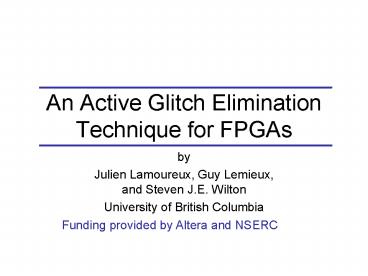An Active Glitch Elimination Technique for FPGAs PowerPoint PPT Presentation
Title: An Active Glitch Elimination Technique for FPGAs
1
An Active Glitch Elimination Technique for FPGAs
- by
- Julien Lamoureux, Guy Lemieux,
and Steven J.E.
Wilton - University of British Columbia
Funding provided by Altera and NSERC
2
Context of this Research
- FPGAs use a lot of power
- Dynamic power still dominates
Source Altera Stratix II Study (99 Circuits)
3
Overview
- Reducing power in FPGAs by minimizing glitching
- Using programmable delay circuits to align
arrival times - Results
- 18 power savings
- 5 area overhead
- 1 critical-path delay overhead
- No changes to the existing CAD flow
4
What is glitching?
- Unnecessary transitions
- Generated by uneven arrival times
- Propagated by certain gates
5
How much glitching is there?
Circuit Switching Activity Functional Glitching Glitching
C1355 0.319 0.231 0.088 27.5
C1908 0.255 0.167 0.088 34.6
C2670 0.267 0.208 0.059 22.2
C3540 0.419 0.230 0.189 45.2
C432 0.260 0.184 0.076 29.3
C499 0.341 0.232 0.109 31.9
C5315 0.400 0.253 0.147 36.7
C6288 1.562 0.295 1.267 81.1
C7552 0.392 0.228 0.165 42.0
C880 0.232 0.186 0.046 19.8
alu4 0.081 0.070 0.011 13.1
apex2 0.049 0.042 0.007 13.7
apex4 0.044 0.030 0.014 32.3
des 0.267 0.169 0.098 36.8
ex1010 0.032 0.015 0.017 52.9
ex5p 0.168 0.082 0.086 51.0
misex3 0.064 0.050 0.013 20.9
pdc 0.035 0.024 0.011 31.8
seq 0.048 0.040 0.008 16.0
spla 0.049 0.028 0.021 42.7
Average - - - 34.1
6
Context of this Research
Circuit Switching Activity Functional Glitching Glitching
C1355 0.319 0.231 0.088 27.5
C1908 0.255 0.167 0.088 34.6
C2670 0.267 0.208 0.059 22.2
C3540 0.419 0.230 0.189 45.2
C432 0.260 0.184 0.076 29.3
C499 0.341 0.232 0.109 31.9
C5315 0.400 0.253 0.147 36.7
C6288 1.562 0.295 1.267 81.1
C7552 0.392 0.228 0.165 42.0
C880 0.232 0.186 0.046 19.8
alu4 0.081 0.070 0.011 13.1
apex2 0.049 0.042 0.007 13.7
apex4 0.044 0.030 0.014 32.3
des 0.267 0.169 0.098 36.8
ex1010 0.032 0.015 0.017 52.9
ex5p 0.168 0.082 0.086 51.0
misex3 0.064 0.050 0.013 20.9
pdc 0.035 0.024 0.011 31.8
seq 0.048 0.040 0.008 16.0
spla 0.049 0.028 0.021 42.7
Average - - - 34.1
- 1/3 of Dynamic Power!
7
Idea
- Use programmable delay circuits to lineup
arrival times.
8
Idea
- Use programmable delay circuits to lineup
arrival times.
9
ASIC vs. FPGA
- ASIC
- Circuit and delays are known before fabrication
- Fixed delay circuits can be used
- FPGA
- Circuit and delays are unknown
- Delay circuits needed to be programmable
- Location of delays must be carefully considered
10
Where should the delays go?
- Option 1 Global Routing
- Option 2 Logic Blocks (LABs)
11
Where in the LAB?
12
Where in the LAB?
13
Where in the LAB?
Too Expensive?
14
4 Schemes
15
Programmable Delay Circuit
16
Programmable Delay Circuit
Biased PMOS
Biased NMOS
17
Programmable Delay Circuit
Biased PMOS
Biasing Circuit
Biased NMOS
18
Calibrating Scheme 1
19
Calibrating Scheme 1
- Three parameters
- Number of delay circuits per LUT
- Maximum delay of the delay circuit
- Minimum delay of the delay circuit
20
Number of delay circuits per LUT
21
Number of delay circuits per LUT
22
Number of delay circuits per LUT
23
Number of delay circuits per LUT
24
Number of delay circuits per LUT
25
Maximum Delay
4ns
26
Maximum Delay
6ns
27
Maximum Delay
8ns
28
Maximum Delay
8ns
29
Minimum Delay Increment
100ps
30
Minimum Delay Increment
200ps
31
Minimum Delay Increment
300ps
32
Minimum Delay Increment
33
Glitch Elimination Results
Circuits Glitch Elimination Glitch Elimination Glitch Elimination Glitch Elimination
Circuits Scheme 1
C1355 92.5
C1908 91.2
C2670 96.3
C3540 84.7
C432 62.8
C499 94.5
C5315 83.9
C6288 62.7
C7552 89.6
C880 84.6
alu4 96.6
apex2 97.0
apex4 95.0
des 86.4
ex1010 89.6
ex5p 82.7
misex3 97.2
pdc 89.3
seq 96.9
spla 95.9
Average 88.5
34
Glitch Elimination Results
Circuits Glitch Elimination Glitch Elimination Glitch Elimination Glitch Elimination
Circuits Scheme 1 Scheme 2 Scheme 3 Scheme 4
C1355 92.5 92.2 89.6 92.2
C1908 91.2 88.4 74.2 93.2
C2670 96.3 90.5 77.3 96.1
C3540 84.7 73.3 74.4 83.9
C432 62.8 65.8 63.4 62.0
C499 94.5 92.5 94.5 94.1
C5315 83.9 71.5 69.6 82.3
C6288 62.7 59.2 56.6 48.8
C7552 89.6 76.3 77.8 90.0
C880 84.6 80.5 81.1 75.7
alu4 96.6 85.6 88.4 96.2
apex2 97.0 86.5 85.9 97.0
apex4 95.0 91.6 88.2 95.0
des 86.4 70.3 75.6 87.2
ex1010 89.6 83.0 79.9 89.4
ex5p 82.7 74.5 71.4 82.2
misex3 97.2 88.8 87.9 97.0
pdc 89.3 75.6 77.8 87.1
seq 96.9 88.9 91.5 96.7
spla 95.9 90.6 91.7 95.9
Average 88.5 81.3 79.8 87.1
35
Overhead
36
Overhead
- Area
- count minimum width transistor areas
- 5.3
37
Overhead
- Area
- count minimum width transistor areas
- 5.3
- Tcrit
- VPR delay HSPICE delay circuit
- 0.21
38
Overhead
- Area
- count minimum width transistor areas
- 5.3
- Tcrit
- VPR delay HSPICE delay circuit
- 0.21
- Power
- VPR power HSPICE delay circuits
- 0.45
39
Overall Results
40
Final Power Savings
Circuits Glitch Elimination Glitch Elimination
Circuits Ideal Scheme 1
C1355 28.8 26.7
C1908 21.1 17.6
C2670 13.4 12.1
C3540 31.7 26.5
C432 17.1 11.2
C499 34.6 33.0
C5315 22.8 19.2
C6288 73.1 46.3
C7552 25.5 22.6
C880 9.6 7.8
alu4 3.6 3.3
apex2 4.3 4.1
apex4 10.1 9.5
des 17.9 15.4
ex1010 18.4 17.1
ex5p 28.1 25.4
misex3 8.1 7.8
pdc 13.3 11.8
seq 6.1 5.9
spla 21.4 20.8
Average 22.6 18.0
41
Summary
- Proposed an active glitch elimination technique
for FPGAs - Examined how to implement the technique
- Reduced power by 18 with only 5 area and 1
speed - Proposed technique requires little or no
modifications to the CAD flow or routing
architecture

